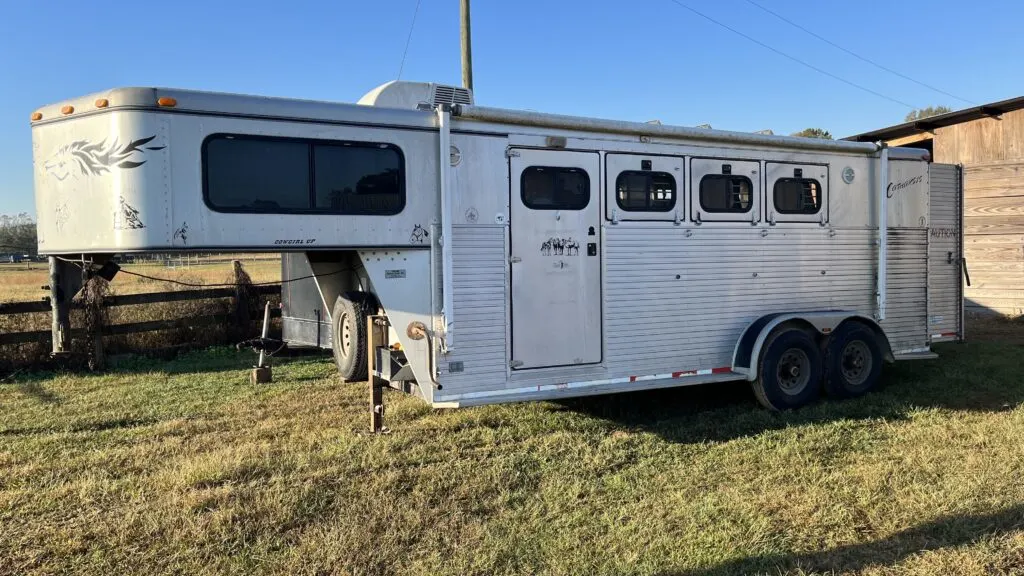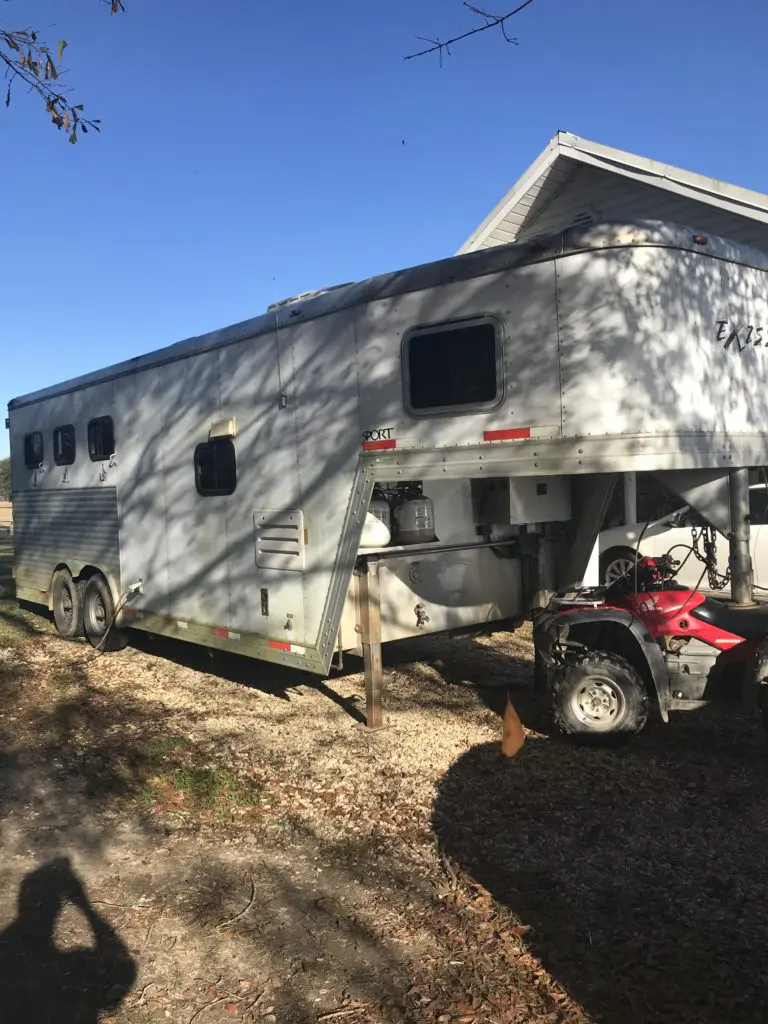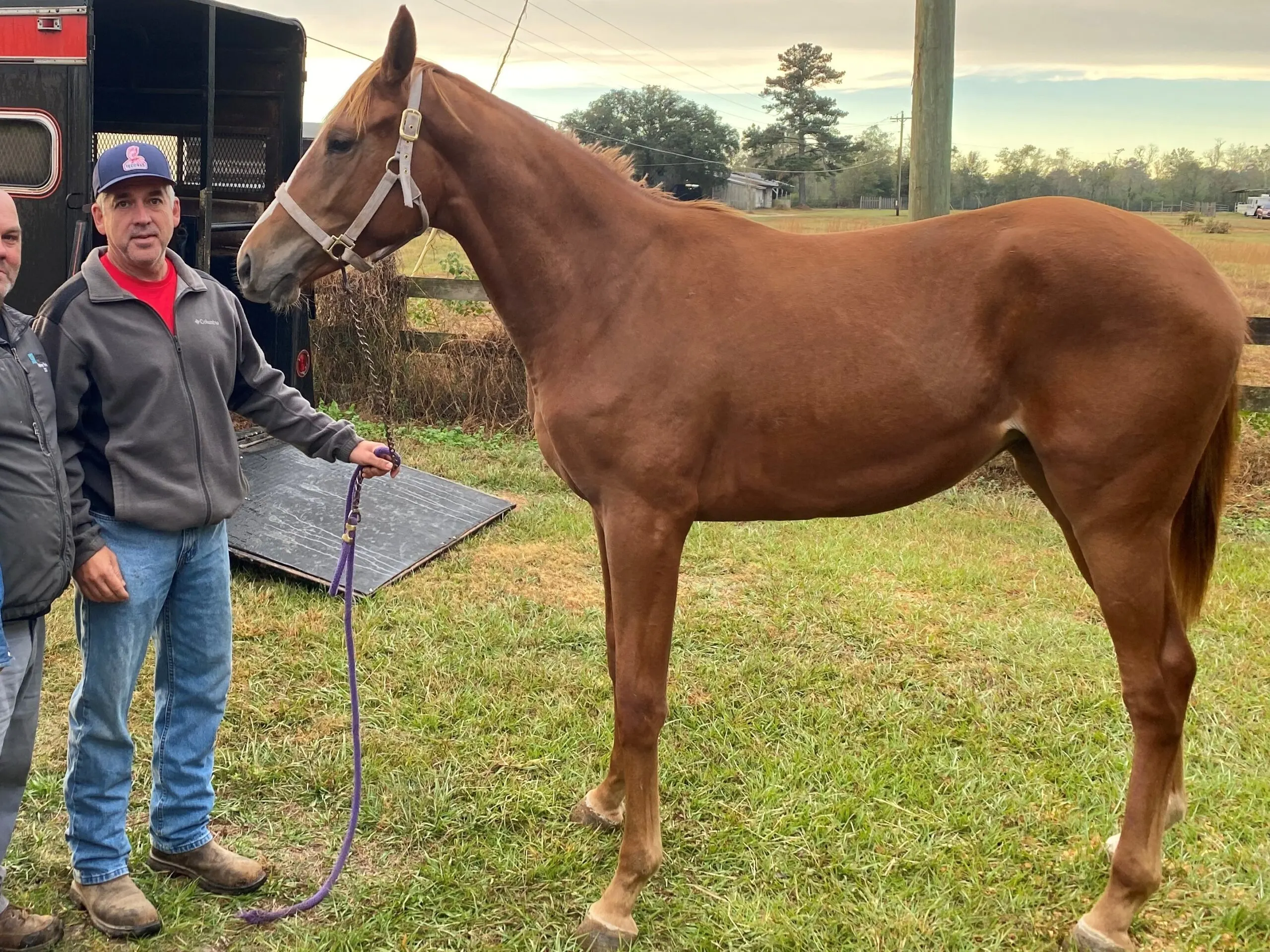Last updated: March 20, 2023
Any links on this page that lead to products on Amazon are affiliate links and I earn a commission if you make a purchase. Thanks in advance – I really appreciate it!
If you’re thinking about buying a gooseneck horse trailer, it’s essential to know what it weighs. The trailer’s weight is critical to ensure your truck is equipped to handle the load and that you arrive safely at your destination.
A standard two-horse gooseneck trailer weighs about 4,000 lbs, a three-horse roughly 5,000 lbs, and a four-horse 6,500 lbs. The weight of a gooseneck horse trailer varies based on the material it’s made of, the number of horses it can hold, and whether or not it has a dressing room or living quarters.
Horse owners that regularly haul multiple horses often opt for a gooseneck horse trailer over a bumper pull model. But it’s important to consider your truck’s towing capacity and the additional weight of the trailer.
Why is trailer weight important?
One of the most important considerations when shopping for a horse trailer is weight. Too much weight can put a strain on the tow vehicle and make it difficult to maneuver.
The goal is to find a trailer that is heavy enough to be safe and stable but not so heavy that it becomes a burden to tow. You want to strike the perfect balance between weight and functionality.
Your trailer’s weight is the starting point used to determine towing safety. Truck makers assign vehicles a maximum gross trailer weight; this is the amount they can tow safely.

The maximum load of a trailer is called its Gross vehicle weight rating (GVWR). The GVWR calculation begins with the trailer’s weight unloaded and then adding each item’s weight, including the horses you load on the trailer.
The GVWR is the universal weight of your trailer plus anything loaded on it, and you can find it on a sticker attached to your trailer’s tongue. Knowing your trailer weight is essential to determine the tow vehicle needed to pull your trailer.
What towing capacity do I need for a gooseneck horse trailer?
The towing capacity you need for a gooseneck horse trailer will depend on the trailer’s weight and the number of horses you plan to transport. Most horse trailers weigh between 4,000 and 7,000 pounds empty, so you will need a vehicle that can tow at least that much.
If you plan to transport multiple horses, you will also need to factor in their weight. A full-grown horse can weigh anywhere from 1,000 to 2,000 pounds, so you will need to make sure your vehicle can handle the additional weight.
Keep in mind that the towing capacity listed on your vehicle’s sticker is the maximum amount it can safely tow; always err on the side of caution when loading up your horse trailer. Note: Your tow vehicle’s ability to pull your trailer is based on the trailer’s weight, not the hitch system type.
What towing capacity do you need to pull a two-horse gooseneck trailer?
I like this question better because we can get some parameters. Let’s start with the typical weight of an empty two-horse gooseneck trailer, 4,000 pounds.
We need to add the weight of two horses, tack, and other miscellaneous items to the empty weight. Even if you only have one horse now, you may need to haul an additional horse one day, so let’s plan for two horses.
For our purpose, let’s assume the horses weigh 1,400 each (yes, I know this is large, but I want to be safe), and our tack and miscellaneous items weigh 500 pounds.
Using my figures, the trailer’s gross vehicle weight is 7,300 pounds. So our question is: what is the towing capacity needed to haul a gooseneck horse trailer with a gross vehicle weight of 7,300 pounds?
You would need a tow vehicle with a towing capacity of 7,300 lbs to haul this two-horse gooseneck trailer. Finding a truck to pull it shouldn’t be too difficult.

Ford’s F150 with a towing package is rated to tow 13,000 lbs, Chevy’s 1,500 Silverado is rated up to 9800 lbs of towing capacity, and the Dodge Ram 1500 can tow 12,750.
Each manufacturer offers options that increase or decrease the trucks’ towing capacity. Another consideration if you’re in the market for a tow vehicle is the type of driving and location you will be hauling your horses.
A strong engine and good trailer brakes are essential if you travel long distances at high speeds or drive in mountainous regions.
How do you find a truck’s towing capacity?
Towing capacity is how much a truck can safely pull. Manufacturers determine a truck’s towing capacity using numerous factors, including the truck’s chassis, engine, transmission, and axles.
Automakers provide information on a vehicle’s towing capacity in the owner’s manual, their website, and a sticker affixed inside the driver’s side door sill on the compliance certification.
Manufacturers also determine a safe overall maximum weight: the truck’s weight plus everything in it, the trailer, and the weight of whatever’s on it; this is the gross vehicle weight rating or GVWR.
Now that you know the vehicle’s towing capacity, you can determine a suitable horse trailer to attach it to. One more thing to keep in mind; you are hauling living animals that shift around in the trailer.
Because horses move when traveling, unlike a tractor, I like to use a truck with a towing capacity rated at least 10 percent above the trailer’s weight. The extra towing capacity probably isn’t necessary, but it adds stability, and I feel safer.

Gooseneck Trailer weights
Keep in mind that not all gooseneck horse trailers are the same. Manufacturers use different materials and construction techniques, affecting the weight and strength of a trailer.
Below is a list of weights for popular sizes and brands of gooseneck trailers. These are estimates based on the manufacturers’ information; however, the weights vary greatly depending on options and lengths.
How much do two-horse gooseneck trailers weigh?
| Brand | Stalls | Weight Empty | GVWR |
|---|---|---|---|
| Sundowner Rancher Special | 2H Slant Load | 3,285 | 8,750 |
| Trails West Adventure | 2H Slant Load | 3980 lbs. | 8,045 |
| Featherlite | 2H Slant | 3,976 lbs | 7,000 |
| Exiss 7200 SR | 2 or 3 horse | 4,700 LBS | 12,000 LBS |
How much do three-horse gooseneck trailers weigh?
| Brand | Stalls | Weight Empty | GVWR |
|---|---|---|---|
| Sundowner Super Sport | 3H Slant Load | 4600 lbs | 13000lbs |
| Trails West Adventure | 3H Slant Load | 5200 lbs. | 10,400lbs |
| Featherlite | 3H Slant | 3950 lbs | 10400 lbs |
| Exiss 7200 SR | 2 or 3 horse | 4,200 LBS | 10400 lbs |
How much do four-horse gooseneck trailers weigh?
| Brand | Stalls | Weight Empty | GVWR |
|---|---|---|---|
| Sundowner | 4H Slant Load | 5100 lbs | 13000lbs |
| Trails West | 4H Slant Load | 5,160 lbs. | 12,000lbs |
| Featherlite | 4H Slant | 5,500 lbs | 12,000 lbs |
| Exiss | 4H Slant | 4640 lbs. | 9995 lbs |
How much do five-horse gooseneck trailers weigh?
| Brand | Stalls | Weight Empty | GVWR |
|---|---|---|---|
| Sundowner | 5H Slant Load | 5,750 lbs | 14000lbs |
| Trails West | 5H Slant Load | 6,000 lbs. | 140000lbs |
| Featherlite | 5H Slant | 6,050 lbs | 14,000 lbs |
| Exiss | 5H Slant | 4640 lbs. | 9995 lbs |
What is the weight of a gooseneck horse trailer with living quarters?
| Brand | Stalls | Weight Empty | GVWR | Living Quarters |
|---|---|---|---|---|
| Sundowner | 3H Slant Load | 13620 lbs | 20000 lbs | w/slide out |
| Trails West | 3H Slant Load | 10,650. | 140000lbs | w/o slide add 1,000lbs for slide |
| Double D | 3H Slant Load | 7,900 lbs | Undetermined | w/o slide out |
| Exiss | 2H Slant | 7,810 lbs | 14,000 lbs | w/slide out |

Why are gooseneck trailers better?
I wouldn’t say gooseneck horse trailers are better, but they provide some benefits not found in a bumper-pull trailer. First, they distribute weight better because the hitching ball is in the truck’s bed instead of its rear.
A heavy load on a bumper-pull trailer can raise your tow vehicle’s front and decrease your truck’s handling capabilities. It’s possible to add a weight-distributing hitch to a bumper pull trailer to help offset the lift, but it’s not as effective as a gooseneck hitch.
I wrote an article about weight-distributing hitches, it provides some helpful information, and I will let you know which ones work best. Best Weight Distributing Hitches for Horse Trailers
Gooseneck trailers are easier to maneuver around curves and are safer for hauling more horses. But some are difficult to hook up and are more expensive than bumper-pull trailers.
I would likely choose a bumper-pull two-horse trailer if I never intended to haul more than two horses and didn’t want a living quarter trailer. My reasons: I wouldn’t take up any room in the truck’s bed; bumper pulls are cheaper and easier to store.
But I would buy a gooseneck for hauling more than two horses, long trips, or if I needed a big tack area or living quarters.

Do I need a CDL to haul a gooseneck trailer?
Commercial driver’s license (CDL) requirements are based on tow and gross vehicle weight, not hitch style. The same standards for a bumper-pull are also applicable to gooseneck trailers.
An important note: Laws change every year, and each state has its particular statutes governing driving requirements. But the federal regulations apply to all states.
You can click here to visit the United States Department of Transportation website to ensure you comply with the current laws.
The current CDL requirement requires a driver to have a CDL if the vehicle or, when combined with the trailer, exceeds a GVWR of 10,001 lbs; however, your state may require a CDL below this threshold.
Below is a helpful YouTube video showing how to weigh your horse trailer.
Related articles:
- Do Horse Trailers Have Brakes? Do They Need Them? 2 Options
- Horse Trailers: Gooseneck or Bumper Pull Which Is Best for You?
- Towing A Two-Horse Bumper Pull Trailer: All You Need To Know
- 10 Best Bumper-Pull Horse Trailers on the Market Right Now
- Slant Load or Straight Load Two-Horse Bumper-Pull Trailer?
- What Size Are Horse Trailer Tires? 7 Essential Tire Facts.
- How Tall is a Horse Trailer? Heights of Popular Models
- 5 Horse Trailer Essentials You Need When Hauling Horses

Meet Miles Henry
An avid equestrian and seasoned racehorse owner, Miles Henry brings his extensive experience to the equine world, proudly associating with the AQHA, The Jockey Club, and various other equine organizations. Beyond the racetrack, Miles is an accomplished author, having published various books about horses, and is a recognized authority in the field, with his work cited in multiple publications.
🔗 Connect with Miles:
Twitter
Facebook
YouTube: Check out race highlights, horse care tips, and more!

